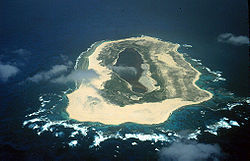Laysan




Laysan (Hawaiian: Kauō), located 930 miles northwest of Honolulu at N25° 42' 14" W171° 44' 04", is one of the Northwestern Hawaiian Islands. It comprises one land mass of 1,016.481 acres (4.114 km²), about 1 by 1.5 miles in size (1.6 by 2.4 km). It is an atoll of sorts, although the land completely surrounds a shallow central lake some eight feet (2.4 meters) above sea level that has a salinity approximately three times greater than the ocean. Lake Laysan is one of only five natural lakes in Hawaii. Laysan's Hawaiian name of Kauō means egg, referring to its shape and how much life springs from the island.
Period of Extinction
Laysan is noted for its bird life; early expeditions to the island in the 19th century estimated the avian population in the seabird colonies at several hundred thousand or even several million. However, the island's ecosystem was all but destroyed by human influence around the turn of the 20th century. A period of guano harvesting lasting about a dozen years was followed by the introduction, for commercial purposes, of rabbits that bred rapidly and devoured all of the island's vegetation (except the tobacco patch), by "King of Laysan", Max Schlemmer. Complaints about this and about Japanese poachers led President Theodore Roosevelt to declare the Northwestern Hawaiian chain a bird sanctuary in 1909. Schlemmer continued to allow the Japanese to export illegal bird wings and so was removed from the island. Without Schlemmer to keep an eye on the rabbits, however, they flourished and multiplied. Also, without plants to hold the earth together, much of the soil and sand became loose and blew about in horrific dust storms. The bird population had by 1923, when the last of the starving rabbits were finally exterminated, been reduced to about a tenth of its former size, and three endemic taxa had become extinct, plus numerous other plant species. Two other endemic species, the Laysan Duck and the Laysan Finch, survive to this day, but are endangered.
Laysan was inhabited by humans for a period in the early 20th century, during the guano mining operations and the introduction of rabbits, but, like most of the Northwestern Hawaiian islands, it now currently uninhabited. It is protected by the Hawaiian Natural Life Act of 1961 and cared for by the U.S. Fish and Wildlife Service, who have had success in eliminating pests, restoring the island to almost pre-desert state, and restoring the numbers of imperiled species.
Possible Ancient Hawaiian Presence
Recently, an archaeologist examining sediment cores found pollen from coconut trees deep below the bottom of the central lagoon. This unexpected find raises several issues. Heretofore, no evidence existed that the coconut ever reached any of the Hawaiian Islands before the arrival of the Polynesian voyagers. Further, there has never been any physical evidence that the ancient Hawaiians extended their explorations of the Hawaiian chain beyond Nihoa and Mokumanamana (Necker). Dating the sediment containing the Cocos pollen is imprecise, but appears to be somewhere between 5,500 years ago, and the arrival of Europeans in Hawaiian waters in the late 1700s. The full length of the core was 70 feet and is thought to represent a record spanning 7,000 years. Coconut pollen was not found in the deeper (older) part of the core. However, cores from Guam in the western Pacific show the presence of coconut trees there as early as 9,000 years ago, well before human habitation. Hawaiian traditions suggest that the Hawaiians were aware that islands existed to the northwest, and the pollen evidence could be interpreted as proof of early Hawaiian visitation to Laysan. Clearly, more precise dating of the sediment layers will be crucial to better interpreting this find (TenBruggencate, 2005).
Bird Species of Laysan
- Laysan Rail (also known as the Laysan Crake)
- Laysan Finch
- Laysan ʻApapane
- Laysan Millerbird
- Laysan Duck
- Laysan Albatross
References
- TenBruggencate, J. 2005. "Coconut pollen found on Laysan". Honolulu Advertiser, Monday, May 23, 2005, p. B1-2.
- Laysan Island: Block 1013, Census Tract 114.98, Honolulu County, Hawaii United States Census Bureau
